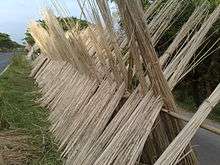Corchorus olitorius
| Corchorus olitorius | |
|---|---|
| | |
| Scientific classification | |
| Kingdom: | Plantae |
| (unranked): | Angiosperms |
| (unranked): | Eudicots |
| (unranked): | Rosids |
| Order: | Malvales |
| Family: | Malvaceae |
| Genus: | Corchorus |
| Species: | C. olitorius |
| Binomial name | |
| Corchorus olitorius L. | |
| Synonyms[1] | |
| |
Corchorus olitorius, commonly known as Nalta jute, tossa jute, Jew's mallow,[2] West African sorrel and bush okra, is a species of shrub in the family Malvaceae. It is the primary source of jute fibre.[3] The leaves and young fruits are used as a vegetable, the dried leaves are used for tea and as a soup thickener, and the seeds are edible.[3]
Distribution
It is unclear whether Corchorus olitorius originated in Africa or in Asia. Some authorities consider that it comes from the Indo-Burmese area or from India, along with several other related species. Others point out that there is a greater genetic variation in Africa and a larger number of wild species in the genus Corchorus. Wherever it originated, it has been under cultivation for a very long time in both continents and probably grows, wild or as a crop, in every country in tropical Africa.[4]
Uses
In India, Bangladesh and other Asian countries, C. olitorius is used for the fibres obtainable from its stem. The crop is cut and then retted in running water to remove the softer tissues, the fibres are then separated from unwanted woody material, cured and dried. The jute fibre prepared in this way is of lesser quality than the white jute obtainable from the closely related Corchorus capsularis.[4]
In Africa and the Middle East, a different type is grown with the leaves and shoots being used for food while the fibre is considered of little importance.[4] This may be the plant mentioned in the Bible (Job XXX, 4) as mallow, but that was probably a member of the Chenopodiaceae, that grows naturally in the salt plains and wilderness that Job was describing, and which is used for food in time of famine. C. olitorius is cultivated even now in Syria and Egypt as a potherb,[5] and its culinary use goes back at least as far as the Ancient Egyptians.[6] It is an important leafy vegetable in Côte d'Ivoire, Benin, Nigeria, Cameroon, Sudan, Uganda, Kenya and Zimbabwe. It is also cultivated and eaten in the Caribbean and Brazil, in the Middle East and in India, Bangladesh, Japan and China. In Nigeria the leaves are boiled to make a sticky, mucilaginous sauce which is served with balls of cassava which are otherwise rather dry.[4]
 Young leaves of jute prepared by cooking in Taiwan
Young leaves of jute prepared by cooking in Taiwan Jute field
Jute field Jute plantation
Jute plantation- Cultivation and processing
 Drying the cane
Drying the cane
- Drying hanks
 Transporting by bicycle cart in Bangladesh
Transporting by bicycle cart in Bangladesh
See also
References
- ↑ "The Plant List: A Working List of All Plant Species". Retrieved 21 May 2015.
- ↑ USDA GRIN Taxonomy, retrieved 21 May 2015
- 1 2 Plants for a Future, retrieved 21 May 2015
- 1 2 3 4 Grubben, G.J.H. (2004). Vegetables. PROTA. pp. 217–221. ISBN 978-90-5782-147-9.
- ↑ Plumptre, Edward Hayes (1874). The Bible educator, ed. by E.H. Plumptre. p. 327.
- ↑ "Jew's mallow". Herbs Info. Retrieved 26 May 2016.
External links
| Wikimedia Commons has media related to Corchorus olitorius. |
| Wikispecies has information related to: Corchorus olitorius |
- Ya Tang, Michael G. Gilbert; Dorr, Laurence J. (2007), "Corchorus olitorius Linnaeus", Flora of China online, 12